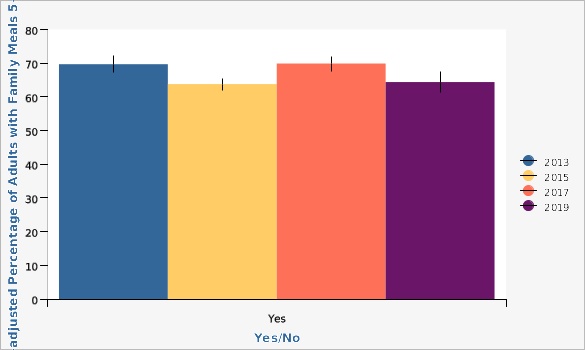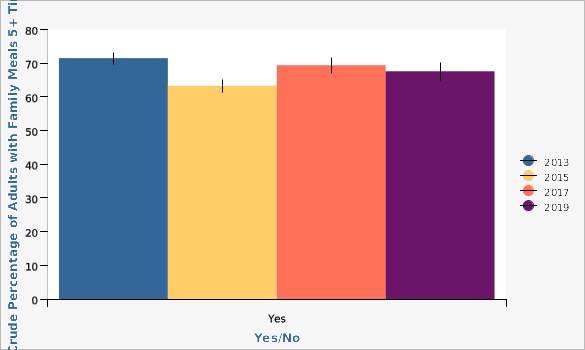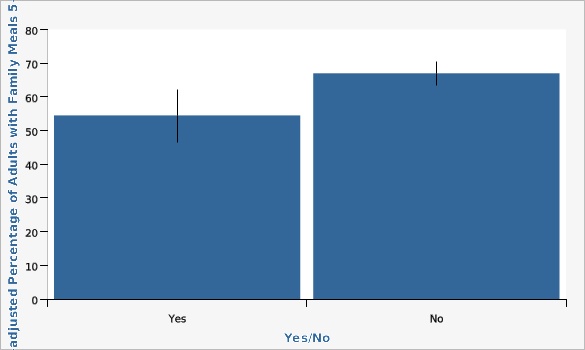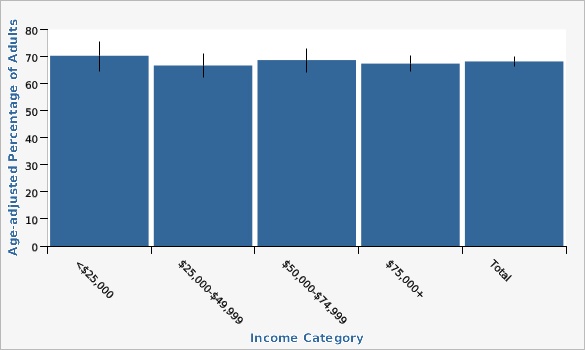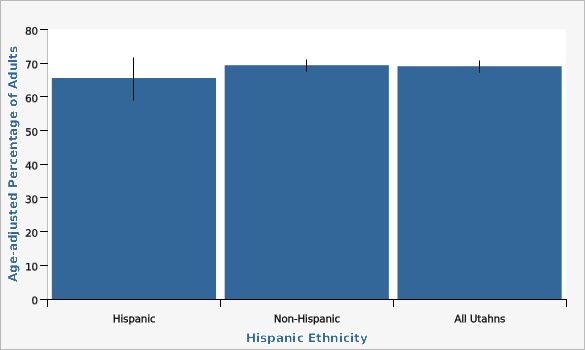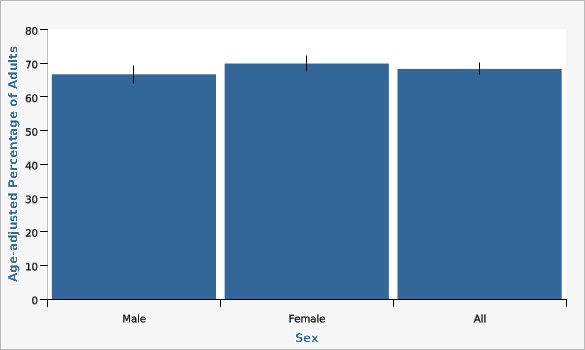Complete Health Indicator Report of Family Meals
Definition
The percentage of adults who live in households where family members ate meals together five or more times in the past seven daysNumerator
Number of adults who live in households where family members ate meals together five or more times in the past seven daysDenominator
Adults in households with children under the age of 18.Why Is This Important?
A number of studies indicate that eating meals as a family is associated with increased consumption of fruits, vegetables, and whole grains. Adolescents who eat more meals with their families may have lower consumption of sugar-sweetened beverages and have a lower body mass index (BMI) than their counterparts who eat fewer meals with their families.Other Objectives
This question supports the efforts of the State Health Improvement Plan which intends to unite the work of the Utah Public Health System through a collective effort with all 13 local health departments. Goal 1 is "Utahns are Eating Healthy and Living Active Lives" with the Strategy 2 "Promote Health Family Meals."How Are We Doing?
The question about family meals was first asked on the 2013 BRFSS. At that time 69.7% of adults reported eating family meals together more than 5 times a week (age-adjusted rates). In 2015 BRFSS, 63.8% of adults reported eating family meals together more than 5 times a week. In 2017, the percentage was 69.9%; and in 2019, it was 64.4%(age-adjusted).How Do We Compare With the U.S.?
This data is not available for the U.S.What Is Being Done?
In 2014, Governor Gary Herbert declared September as Healthy Utah Family Meals Month. As of 2021, this declaration is still in effect. Local health departments have conducted campaigns to increase the number of meals family members eat together. HEAL created a video with Utah Governor Spencer Cox ( Lt. Governor at the time) that shows him in his home preparing and eating a meal with his family. Please see [https://www.youtube.com/watch?v=i8TbyF4aN9Y].Health Program Information
The Utah Department of Health Healthy Environments Active Living program plays a key role in improving the health of residents in the state of Utah. The program was formed in July 2013 (as EPICC), through a new funding opportunity from the Centers for Disease Control and Prevention (CDC) that allowed for the merging of three previously existing programs: the Heart Disease and Stroke Prevention Program, the Diabetes Prevention and Control Program, and the Physical Activity, Nutrition, and Obesity Program, as well as the addition of a school health program. The Healthy Environments Active Living Program was recently restructured as part of this strategic planning process and the new program model focuses on working together with staff and partners to address the social determinants of health while advancing health equity and increasing policy, systems, and environmental changes. Overarching Goals: Healthy People: Increase access to resources that empower all people in Utah to reach their full health potential. Healthy Communities: Increase the capacity of communities to support and promote healthy living for all individuals. Equitable Society: Increase opportunities for people who are under-resourced and under-represented in Utah to live healthy and thriving lives.Related Indicators
Related Relevant Population Characteristics Indicators:
Health Status Outcomes
Frequency of family meals has been positively associated with intake of fruits and vegetables in adults, and negatively associated with sweets and sugar-sweetened beverages in adolescents. Family meals have been positively correlated with perceived family cohesion.[[br]] [[br]] ---- Welsh EM, French SA, Wall M. Examining the relationship between family meal frequency and individual dietary intake: does family cohesion play a role? J Nutr Educ Behav. 2011;43(4):229?35.Related Health Status Outcomes Indicators:
Graphical Data Views
The percentage of adults who eat meals with their families five times a week or more has remained fairly consistent.
| Odd Years | Yes/No | Age-adjusted Percentage of Adults with Family Meals 5+ Times | Lower Limit | Upper Limit | ||
|---|---|---|---|---|---|---|
Record Count: 4 | ||||||
| 2013 | Yes | 69.7 | 67.2 | 72.2 | ||
| 2015 | Yes | 63.8 | 61.8 | 65.6 | ||
| 2017 | Yes | 69.9 | 67.6 | 72.1 | ||
| 2019 | Yes | 64.4 | 61.2 | 67.5 | ||
Data Notes
The question was only asked to adults in households with children under the age of 18 (approximately 40% of the sample).The percentage of adults who eat meals with their families five times a week or more has remained fairly consistent.
| Odd Years | Yes/No | Crude Percentage of Adults with Family Meals 5+ Times | Lower Limit | Upper Limit | ||
|---|---|---|---|---|---|---|
Record Count: 4 | ||||||
| 2013 | Yes | 71.5 | 69.7 | 73.2 | ||
| 2015 | Yes | 63.3 | 61.4 | 65.3 | ||
| 2017 | Yes | 69.4 | 67.0 | 71.7 | ||
| 2019 | Yes | 67.6 | 65.0 | 70.1 | ||
Data Notes
The question was only asked to adults in households with children under the age of 18 (approximately 40% of the sample).Food insecurity is defined as always/usually/sometimes in the past 12 months being worried or stressed about having enough money to buy nutritious meals. Overall, 64.4% of adults had family meals 5 or more times a week. However, only 54.5% of adults with food insecurity had family meals 5+ times per week. Two-thirds, 67.0%, of adults without food insecurity had family meals 5+ times per week. Percentages are age-adjusted.
| Odd Years | Yes/No | Age-adjusted Percentage of Adults with Family Meals 5+ Times | Lower Limit | Upper Limit | ||
|---|---|---|---|---|---|---|
Record Count: 2 | ||||||
| 2019 | Yes | 54.5% | 46.6% | 62.2% | ||
| 2019 | No | 67.0% | 63.5% | 70.4% | ||
Data Notes
The question was only asked to adults in households with children under the age of 18 (approximately 40% of the sample). Age-adjusted to 2000 U.S. standard population.Data Source
Utah Data: Behavioral Risk Factor Surveillance System, Office of Public Health Assessment, Utah Department of HealthJust over 70% (70.3%) of adults in households with annual incomes of less than $25,000 had family meals 5 times a week or more, but the percentage was not statistically different from the state.
| Income Category | Age-adjusted Percentage of Adults | Lower Limit | Upper Limit | |||
|---|---|---|---|---|---|---|
Record Count: 5 | ||||||
| <$25,000 | 70.3% | 64.4% | 75.5% | |||
| $25,000-$49,999 | 66.7% | 62.1% | 71.0% | |||
| $50,000-$74,999 | 68.7% | 64.0% | 73.0% | |||
| $75,000+ | 67.4% | 64.4% | 70.3% | |||
| Total | 68.2% | 66.2% | 70.0% | |||
Data Notes
The question was only asked to adults in households with children under the age of 18 (approximately 40% of the sample). Age-adjusted to 2000 U.S. standard population.Data Source
Utah Data: Behavioral Risk Factor Surveillance System, Office of Public Health Assessment, Utah Department of HealthAmong adults there was no statistically significant difference between weight status and frequency of family meals.
| Weight Category | Age-adjusted Percentage of Adults | Lower Limit | Upper Limit | |||
|---|---|---|---|---|---|---|
Record Count: 3 | ||||||
| Normal | 69.6% | 66.3% | 72.7% | |||
| Overweight | 68.0% | 64.7% | 71.2% | |||
| Obese | 67.1% | 63.7% | 70.4% | |||
Data Notes
The question was only asked to adults in households with children under the age of 18 (approximately 40% of the sample). Age-adjusted to 2000 U.S. standard population.Data Source
Utah Data: Behavioral Risk Factor Surveillance System, Office of Public Health Assessment, Utah Department of HealthThere is no statistically significant differences between ethnicity category and family meals eaten together.
| Hispanic Ethnicity | Age-adjusted Percentage of Adults | Lower Limit | Upper Limit | |||
|---|---|---|---|---|---|---|
Record Count: 3 | ||||||
| Hispanic | 65.6% | 58.9% | 71.7% | |||
| Non-Hispanic | 69.4% | 67.5% | 71.2% | |||
| All Utahns | 69.1% | 67.3% | 70.8% | |||
Data Notes
The question was only asked to adults in households with children under the age of 18 (approximately 40% of the sample). Age-adjusted to 2000 U.S. standard population.Data Source
Utah Data: Behavioral Risk Factor Surveillance System, Office of Public Health Assessment, Utah Department of HealthFemales have higher rates of eating meals with a family 5 or more times a week than males.
| Sex | Age-adjusted Percentage of Adults | Lower Limit | Upper Limit | |||
|---|---|---|---|---|---|---|
Record Count: 3 | ||||||
| Male | 66.7% | 64.0% | 69.2% | |||
| Female | 69.9% | 67.4% | 72.3% | |||
| All | 68.3% | 66.5% | 70.1% | |||
Data Notes
The question was only asked to adults in households with children under the age of 18 (approximately 40% of the sample). Age-adjusted to 2000 U.S. standard population.Data Source
Utah Data: Behavioral Risk Factor Surveillance System, Office of Public Health Assessment, Utah Department of HealthFamily Meals by Local Health District, Utah, 2017, 2019
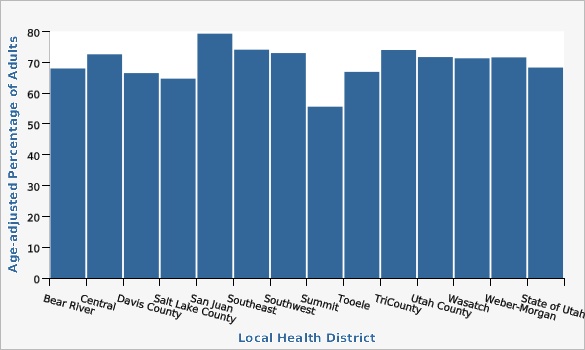
More than 68% (68.3%)of adults reported eating a meal together as a family 5 or more times a week.
| Local Health District | Age-adjusted Percentage of Adults | Lower Limit | Upper Limit | |||
|---|---|---|---|---|---|---|
Record Count: 14 | ||||||
| Bear River | 68.0% | 59.7% | 75.3% | |||
| Central | 72.6% | 64.8% | 79.2% | |||
| Davis County | 66.5% | 60.4% | 72.2% | |||
| Salt Lake County | 64.7% | 61.2% | 68.0% | |||
| San Juan | 79.3% | 66.1% | 88.3% | |||
| Southeast | 74.1% | 64.2% | 82.0% | |||
| Southwest | 73.0% | 67.2% | 78.1% | |||
| Summit | 55.6% | 42.6% | 67.8% | |||
| Tooele | 66.9% | 58.5% | 74.4% | |||
| TriCounty | 74.0% | 65.8% | 80.9% | |||
| Utah County | 71.7% | 67.8% | 75.3% | |||
| Wasatch | 71.3% | 59.9% | 80.5% | |||
| Weber-Morgan | 71.6% | 65.7% | 76.8% | |||
| State of Utah | 68.3% | 66.5% | 70.1% | |||
Data Notes
The question was only asked to adults in households with children under the age of 18 (approximately 40% of the sample). Age-adjusted to 2000 U.S. standard population.Data Source
Utah Data: Behavioral Risk Factor Surveillance System, Office of Public Health Assessment, Utah Department of HealthReferences and Community Resources
MyPlate, MyWins for Families has tips for involving children and teens in family meals. See [https://www.choosemyplate.gov/families#kids]. Dwyer, L., Oh, A., Patrick, H., & Hennessy, E. (2015). Promoting family meals: a review of existing interventions and opportunities for future research. Adolescent Health, Medicine and Therapeutics, 6, 115-131. [http://doi.org/10.2147/AHMT.S37316] Hauser SI, Economos CD, Nelson ME, Goldberg JP, Hyatt RR, Naumova EN, et al. Household and family factors related to weight status in first through third graders: a cross-sectional study in Eastern Massachusetts. BMC Pediatr. 2014;14(1):1. Larson NI, Neumark-Sztainer D, Hannan PJ, Story M. Family meals during adolescence are associated with higher diet quality and healthful meal patterns during young adulthood. J Am Diet Assoc. 2007;107(9):1502-10. Rockett HRH. Family Dinner: More than Just a Meal. J Am Diet Assoc. 2007 Sep;107(9):1498-501. Welsh EM, French SA, Wall M. Examining the relationship between family meal frequency and individual dietary intake: does family cohesion play a role? J Nutr Educ Behav. 2011;43(4):229-35.More Resources and Links
Evidence-based community health improvement ideas and interventions may be found at the following sites:- Centers for Disease Control and Prevention (CDC) WONDER Database, a system for disseminating public health data and information.
- United States Census Bureau data dashboard.
- Utah healthy Places Index, evidence-based and peer-reviewed tool, supports efforts to prioritize equitable community investments, develop critical programs and policies across the state, and much more.
- County Health Rankings
- Kaiser Family Foundation's StateHealthFacts.org
- Medical literature can be queried at PubMed library.
Page Content Updated On 04/08/2021,
Published on 12/09/2021

